Abstract
Inhaled substances can modify behavior by their toxic action, or because they are discriminable events, or because they can support or suppress behavior. They can be used as discriminative stimuli at concentrations above the olfactory threshold. Inhalants can elicit unconditioned reflexes. As aversive stimuli, they can be studied in respondent conditioning experiments (e.g. conditioned suppression), in punishment paradigms, or as negative reinforcers in escape paradigms. Inhalants can also be positive reinforcers; their intoxicating properties have engendered patterns of chronic self-administration (solvent abuse). Such stimulus properties should be considered in industrial hygiene and environmental quality decisions. Laboratory techniques to study such properties abound.
Full text
PDF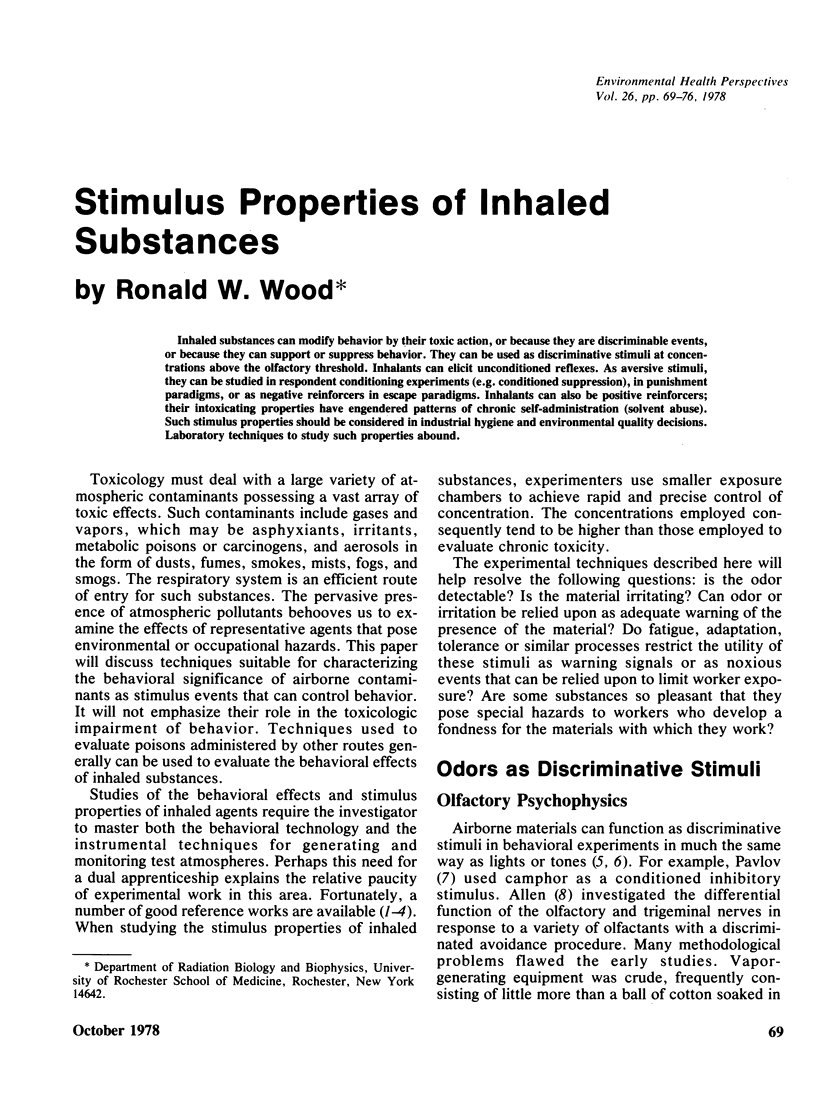
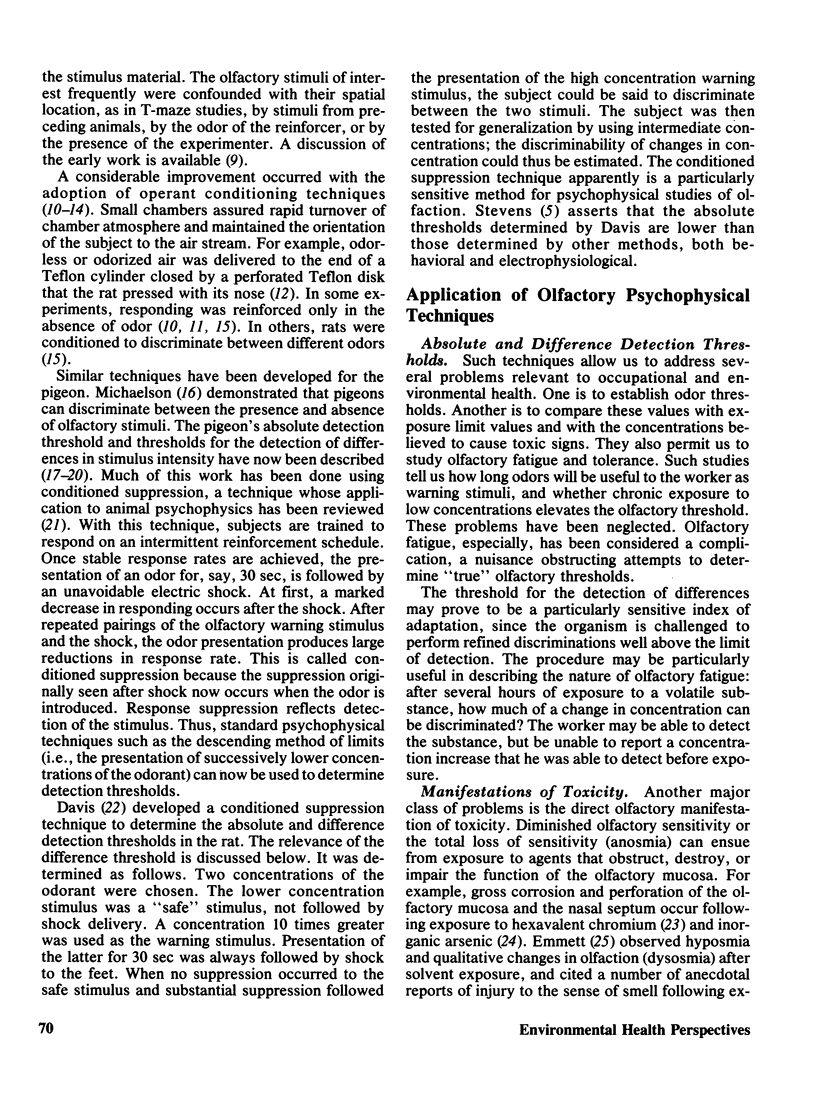
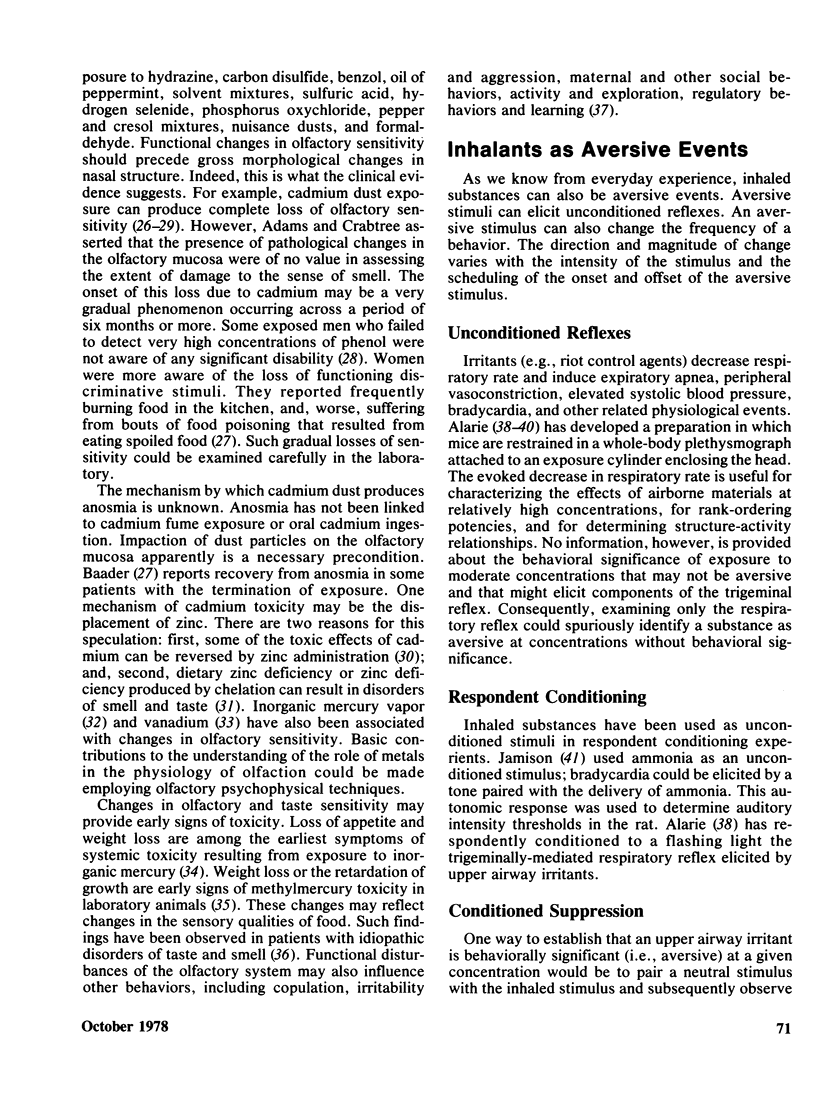
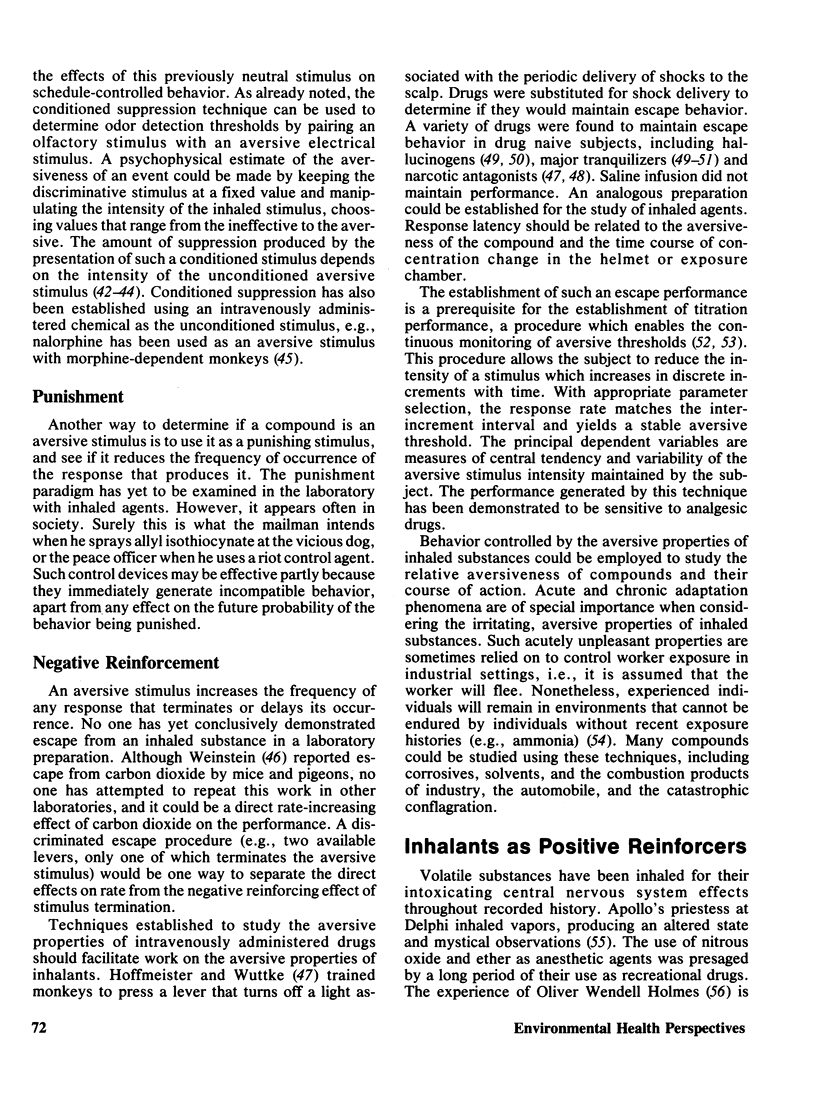

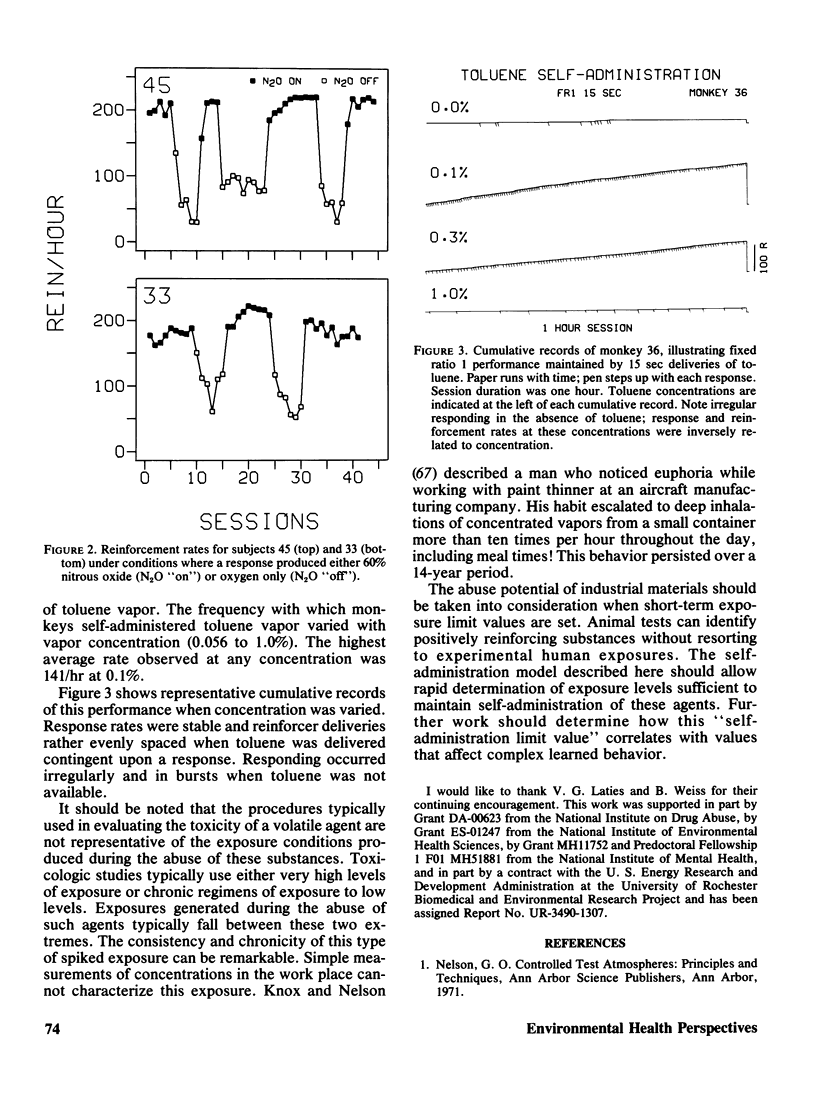
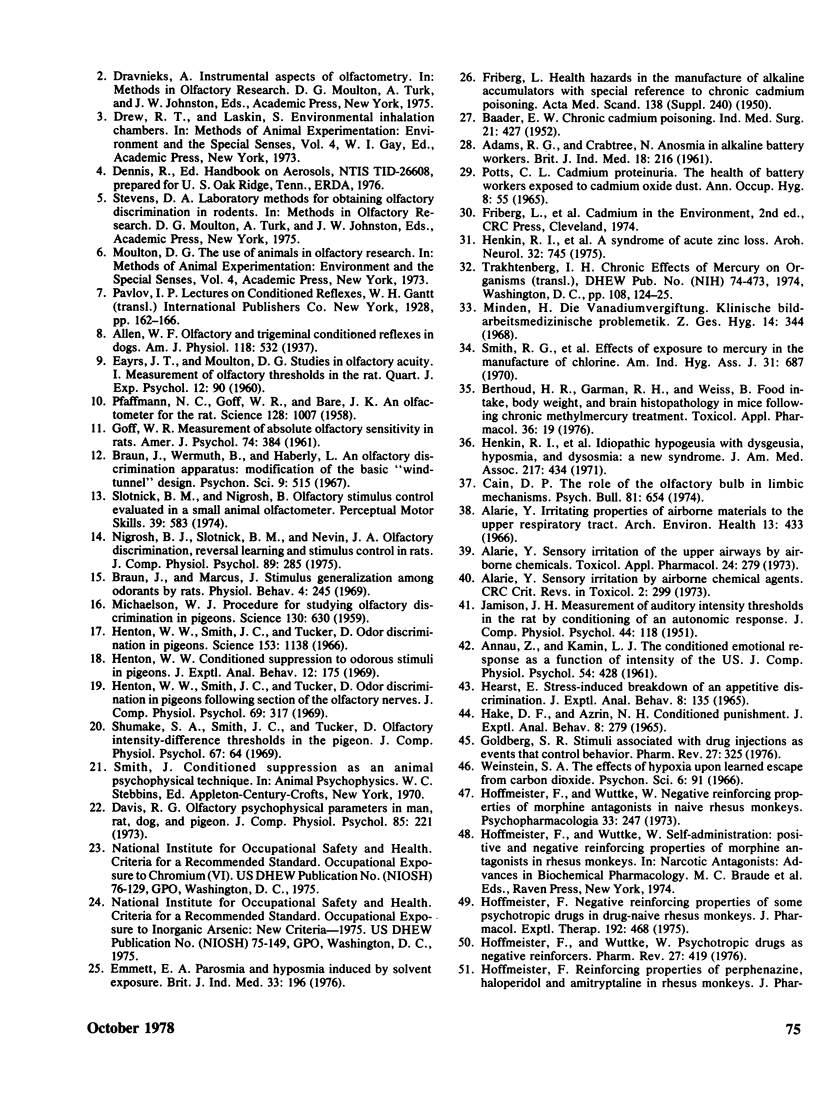
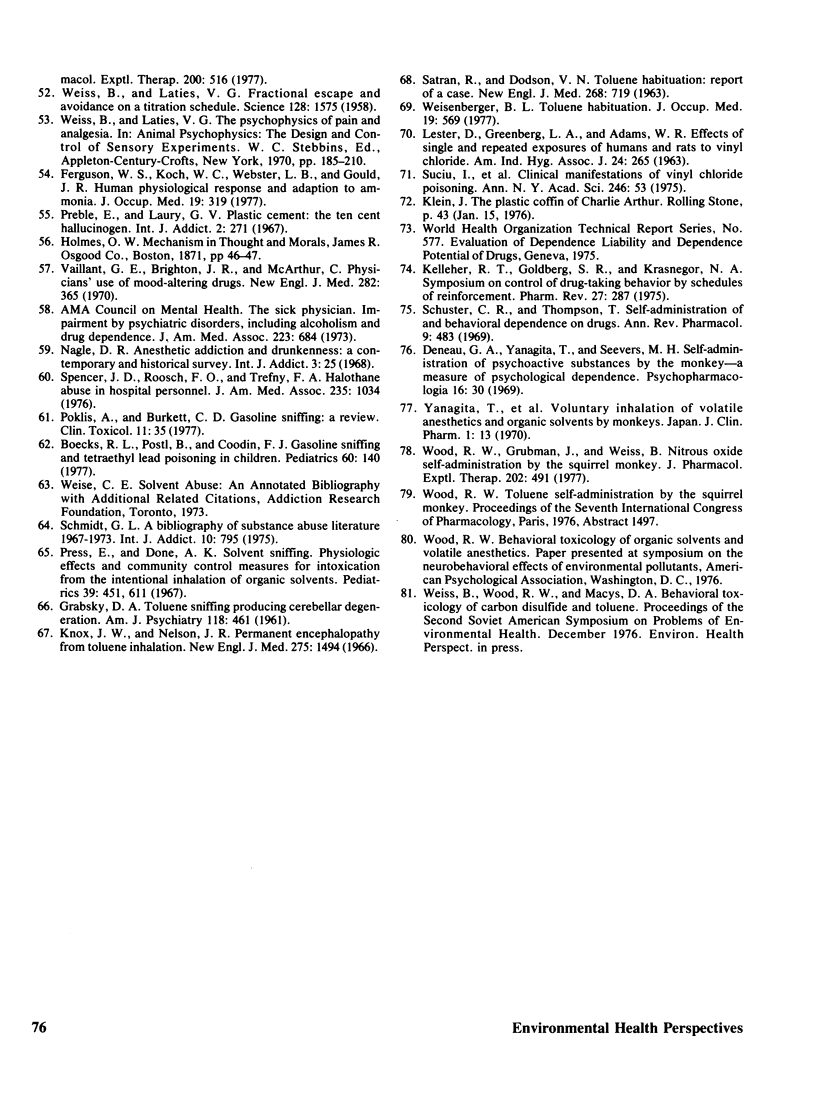
Images in this article
Selected References
These references are in PubMed. This may not be the complete list of references from this article.
- ADAMS R. G., CRABTREE N. Anosmia in alkaline battery workers. Br J Ind Med. 1961 Jul;18:216–221. doi: 10.1136/oem.18.3.216. [DOI] [PMC free article] [PubMed] [Google Scholar]
- ANNAU Z., KAMIN L. J. The conditioned emotional response as a function of intensity of the US. J Comp Physiol Psychol. 1961 Aug;54:428–432. doi: 10.1037/h0042199. [DOI] [PubMed] [Google Scholar]
- Alarie Y. Irritating properties of airborne materials to the upper respiratory tract. Arch Environ Health. 1966 Oct;13(4):433–449. doi: 10.1080/00039896.1966.10664593. [DOI] [PubMed] [Google Scholar]
- Alarie Y. Sensory irritation by airborne chemicals. CRC Crit Rev Toxicol. 1973 Nov;2(3):299–363. doi: 10.3109/10408447309082020. [DOI] [PubMed] [Google Scholar]
- Alarie Y. Sensory irritation of the upper airways by airborne chemicals. Toxicol Appl Pharmacol. 1973 Feb;24(2):279–297. doi: 10.1016/0041-008x(73)90148-8. [DOI] [PubMed] [Google Scholar]
- BAADER E. W. Chronic cadmium poisoning. Ind Med Surg. 1952 Sep;21(9):427–430. [PubMed] [Google Scholar]
- Berthoud H. R., Garman R. H., Weiss B. Food intake, body weight, and brain histopathology in mice following chronic methylmercury treatment. Toxicol Appl Pharmacol. 1976 Apr;36(1):19–30. doi: 10.1016/0041-008x(76)90023-5. [DOI] [PubMed] [Google Scholar]
- Boeckx R. L., Postl B., Coodin F. J. Gasoline sniffing and tetraethyl lead poisoning in children. Pediatrics. 1977 Aug;60(2):140–145. [PubMed] [Google Scholar]
- Cain D. P. The role of the olfactory bulb in limbic mechanisms. Psychol Bull. 1974 Oct;81(10):654–671. doi: 10.1037/h0036954. [DOI] [PubMed] [Google Scholar]
- Davis R. G. Olfactory psychophysical parameters in man, rat, dog, and pigeon. J Comp Physiol Psychol. 1973 Nov;85(2):221–232. doi: 10.1037/h0035053. [DOI] [PubMed] [Google Scholar]
- Deneau G., Yanagita T., Seevers M. H. Self-administration of psychoactive substances by the monkey. Psychopharmacologia. 1969;16(1):30–48. doi: 10.1007/BF00405254. [DOI] [PubMed] [Google Scholar]
- Emmett E. A. Parosmia and hyposmia induced by solvent exposure. Br J Ind Med. 1976 Aug;33(3):196–198. doi: 10.1136/oem.33.3.196. [DOI] [PMC free article] [PubMed] [Google Scholar]
- Ferguson W. S., Koch W. C., Webster L. B., Gould J. R. Human physiological response and adaption to ammonia. J Occup Med. 1977 May;19(5):319–326. [PubMed] [Google Scholar]
- GOFF W. R. Measurement of absolute olfactory sensitivity in rats. Am J Psychol. 1961 Sep;74:384–393. [PubMed] [Google Scholar]
- GRABSKI D. A. Toluene sniffing producing cerebellar degeneration. Am J Psychiatry. 1961 Nov;118:461–462. doi: 10.1176/ajp.118.5.461. [DOI] [PubMed] [Google Scholar]
- Goldberg S. R. Stimuli associated with drug injections as events that control behavior. Pharmacol Rev. 1975 Sep;27(3):325–340. [PubMed] [Google Scholar]
- HAKE D. F., AZRIN N. H. CONDITIONED PUNISHMENT. J Exp Anal Behav. 1965 Sep;8:279–293. doi: 10.1901/jeab.1965.8-279. [DOI] [PMC free article] [PubMed] [Google Scholar]
- HEARST E. STRESS-INDUCED BREAKDOWN OF AN APPETITIVE DISCRIMINATION. J Exp Anal Behav. 1965 May;8:135–146. doi: 10.1901/jeab.1965.8-135. [DOI] [PMC free article] [PubMed] [Google Scholar]
- Henkin R. I., Patten B. M., Re P. K., Bronzert D. A. A syndrome of acute zinc loss. Cerebellar dysfunction, mental changes, anorexia, and taste and smell dysfunction. Arch Neurol. 1975 Nov;32(11):745–751. doi: 10.1001/archneur.1975.00490530067006. [DOI] [PubMed] [Google Scholar]
- Henkin R. I., Schechter P. J., Hoye R., Mattern C. F. Idiopathic hypogeusia with dysgeusia, hyposmia, and dysosmia. A new syndrome. JAMA. 1971 Jul 26;217(4):434–440. [PubMed] [Google Scholar]
- Henton W. W. Conditioned suppression to odorous stimuli in pigeons. J Exp Anal Behav. 1969 Jan;12(1):175–185. doi: 10.1901/jeab.1969.12-175. [DOI] [PMC free article] [PubMed] [Google Scholar]
- Henton W. W., Smith J. C., Tucker D. Odor discrimination in pigeons following section of the olfactory nerves. J Comp Physiol Psychol. 1969 Oct;69(2):317–323. doi: 10.1037/h0028157. [DOI] [PubMed] [Google Scholar]
- Henton W. W., Smith J. C., Tucker D. Odor discrimination in pigeons. Science. 1966 Sep 2;153(3740):1138–1139. doi: 10.1126/science.153.3740.1138. [DOI] [PubMed] [Google Scholar]
- Hoffmeister F. Negative reinforcing properties of some psychotropic drugs in drug-naive rhesus monkeys. J Pharmacol Exp Ther. 1975 Feb;192(2):468–477. [PubMed] [Google Scholar]
- Hoffmeister F., Wuttke W. Negative reinforcing properties of morphine-antagonists in naive rhesus monkeys. Psychopharmacologia. 1973;33(3):247–258. doi: 10.1007/BF00423059. [DOI] [PubMed] [Google Scholar]
- Hoffmeister F., Wuttke W. Psychotropic drugs as negative reinforcers. Pharmacol Rev. 1975 Sep;27(3):419–428. [PubMed] [Google Scholar]
- JAMISON J. H. Measurement of auditory intensity thresholds in the rat by conditioning of an autonomic response. J Comp Physiol Psychol. 1951 Apr;44(2):118–125. doi: 10.1037/h0058322. [DOI] [PubMed] [Google Scholar]
- Knox J. W., Nelson J. R. Permanent encephalopathy from toluene inhalation. N Engl J Med. 1966 Dec 29;275(26):1494–1496. doi: 10.1056/NEJM196612292752608. [DOI] [PubMed] [Google Scholar]
- LESTER D., GREENBERG L. A., ADAMS W. R. Effects of single and repeated exposures of humans and rats to vinyl chloride. Am Ind Hyg Assoc J. 1963 May-Jun;24:265–275. doi: 10.1080/00028896309342963. [DOI] [PubMed] [Google Scholar]
- Michelsen W. J. Procedure for Studying Olfactory Discrimination in Pigeons. Science. 1959 Sep 11;130(3376):630–631. doi: 10.1126/science.130.3376.630. [DOI] [PubMed] [Google Scholar]
- Minden H. Die Vanadiumvergiftung. Klinisches Bild--arbeitsmedizinische Problematik. Z Gesamte Hyg. 1968 May;14(5):344–347. [PubMed] [Google Scholar]
- Nigrosh B. J., Slotnick B. M., Nevin J. A. Olfactory discrimination, reversal learning, and stimulus control in rats. J Comp Physiol Psychol. 1975 Jun;89(4):285–294. doi: 10.1037/h0076821. [DOI] [PubMed] [Google Scholar]
- PFAFFMANN C. An olfactometer for the rat. Science. 1958 Oct 24;128(3330):1007–1008. doi: 10.1126/science.128.3330.1007. [DOI] [PubMed] [Google Scholar]
- POTTS C. L. CADMIUM PROTEINURIA--THE HEALTH OF BATTERY WORKERS EXPOSED TO CADMIUM OXIDE DUST. Ann Occup Hyg. 1965 Mar;8:55–61. doi: 10.1093/annhyg/8.1.55. [DOI] [PubMed] [Google Scholar]
- Press E., Done A. K. Solvent sniffing. Physiologic effects and community control measures for intoxication from the intentional inhalation of organic solvents. II. Pediatrics. 1967 Apr;39(4):611–622. [PubMed] [Google Scholar]
- SATRAN R., DODSON V. N. Toluene habituation. Report of a case. N Engl J Med. 1963 Mar 28;268:719–721. doi: 10.1056/NEJM196303282681308. [DOI] [PubMed] [Google Scholar]
- Schmidt G. L. A bibliography of substance abuse literature 1967-1973. Int J Addict. 1975;10(5):795–800. doi: 10.3109/10826087509027338. [DOI] [PubMed] [Google Scholar]
- Schuster C. R., Thompson T. Self administration of and behavioral dependence on drugs. Annu Rev Pharmacol. 1969;9:483–502. doi: 10.1146/annurev.pa.09.040169.002411. [DOI] [PubMed] [Google Scholar]
- Shumake S. A., Smith J. C., Tucker D. Olfactory intensity-difference thresholds in the pigeon. J Comp Physiol Psychol. 1969 Jan;67(1):64–69. doi: 10.1037/h0026669. [DOI] [PubMed] [Google Scholar]
- Slotnick B. M., Nigrosh B. J. Olfactory stimulus control evaluated in a small animal olfactometer. Percept Mot Skills. 1974 Aug;39(1 Pt 2):583–597. doi: 10.2466/pms.1974.39.1.583. [DOI] [PubMed] [Google Scholar]
- Smith R. G., Vorwald A. J., Patil L. S., Mooney T. F., Jr Effects of exposure to mercury in the manufacture of chlorine. Am Ind Hyg Assoc J. 1970 Nov-Dec;31(6):687–700. doi: 10.1080/0002889708506315. [DOI] [PubMed] [Google Scholar]
- Spencer J. D., Raasch F. O., Trefny F. A. Halothane abuse in hospital personnel. JAMA. 1976 Mar 8;235(10):1034–1035. [PubMed] [Google Scholar]
- Vaillant G. E., Brighton J. R., McArthur C. Physicians' use of mood-altering drugs. A 20-year follow-up report. N Engl J Med. 1970 Feb 12;282(7):365–370. doi: 10.1056/NEJM197002122820705. [DOI] [PubMed] [Google Scholar]
- WEISS B., LATIES V. G. Fractional escape and avoidance on a titration schedule. Science. 1958 Dec 19;128(3338):1575–1576. doi: 10.1126/science.128.3338.1575. [DOI] [PubMed] [Google Scholar]
- Weisenberger B. L. Toluene habituation. J Occup Med. 1977 Aug;19(8):569–570. [PubMed] [Google Scholar]
- Wood R. W., Grubman J., Weiss B. Nitrous oxide self-administration by the squirrel monkey. J Pharmacol Exp Ther. 1977 Sep;202(3):491–499. [PubMed] [Google Scholar]



